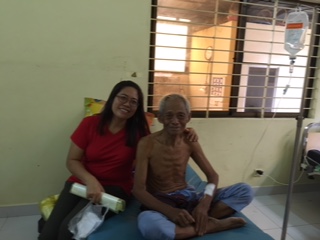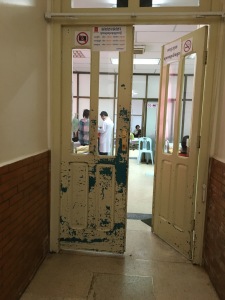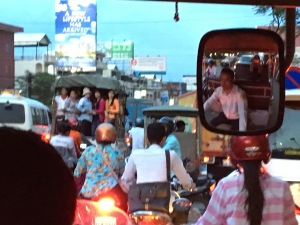I am waiting for the daily supply boat to arrive at the island and take me back to civilization. It will arrive in the next few hours, bringing rice and other supplies for the people who live here (the population comprising one indigenous village and a handful of hippy hostels and scuba-diving schools). I lean back against the tangled roots of a mangrove tree and close my eyes. The vast majority of Koh Rong Saloem, a small island off the southern coast of Cambodia, is inpenetrable jungle – there are no roads and the electricity is available only when the generator runs, from 6pm to 11pm. I have spent the last few days of my travels alone in a bamboo hut – meditating, walking through jungle, swimming, reflecting.
As I wait on the wooden pier, signs of an imminent monsoon appear. There is no particular diurnal rhythm to the monsoons on these islands, but they are usually daily, and are always preceded by a hot, strong breeze, and usually in my case by a peculiar unilateral headache (must be my internal barometer). As the first drops begin, I lean my head back and let them wash over me. Then there is a jag of lightening and an extended rumble of thunder. The wind picks up and the rain begins to drive sideways. Grabbing my rucksack, I run for one of the makeshift shelters the fisherman have built here – really, nothing more than a tarpaulin draped over a rope strung between two palms. I sit on the floor with some of the Khmer fisherman and together we watch the rain in silence.
The rain on the corrugated metal roof makes a loud, persistent hammering, melodic, in a death-metal kind of way. Every now and then it increases in tempo. The sheer force of it is unnerving. It feels as though the flimsy shacks will be washed away. Rivulets of orange brown water snake down to the short and merge with the churning waves. I feel a little afraid of the power of the storm – particularly as I am about to board a small wooden boat that will take around three hours to cross the stretch of water between Koh Rong Samloen and Sihanoukhville. The boat arrives and I clamber down the slippery wooden ladder on to the soaked deck. Alongside sacks of rice and boxes of tobacco, I squat with my back against my rucksack. The boat heaves its’ way from the island, lurching and leaning as it cuts across the waves, and then returning to equilibrium with a thud. The rain splatters everything, and the waves, whipped up by the winds, spray salt into my face and hair. I soon learn not to fear the tilt of the vessel when I see the crew and villagers smile and chatter continuously throughout the journey, laughing loudly when someone slips and falls on the wet decking or tries to light a cigarette, only to have it whipped from his mouth and cast into the whirling storm. I cannot see further than the edge of the boat for the torrential downpour.
The boat pulls alongside the pier in Sihanoukville and we clamber out, drenched and exhilarated. The storm continues for most of the day. Seven hours later I am in Phnom Penh. Many of the streets are flooded, the streets gridlocked and the open drains are almost full with brown water and floating waste. I am losing my earlier euphoria as exhaustion sets in. Despite my rain cover the water has penetrated my rucksack and soaked everything. I do not remember arriving at the homestay or falling on to the bed, fully dressed. But that is how I find myself when I wake early the next morning with the sound of the waking city. Outside my door, the sun blazes. My clothes, laid out on the metal roof of the hut next door, have dried. The streets are dry, the sky clear, the air alive with the smells of cooking from the street vendors and their open fires. There is no trace of the monsoon.

The storms in our lives come and they go. In their grip, we are buffeted and drenched, our vision temporarily obscured. We have a choice. We can resist the rain and wind, turn away from it, tighten our grip on our possessions and try to protect them at all costs. Or we can surrender to the storms, recognize their inevitability, and allow ourselves to experience them fully. The temporary discomfort becomes a memory.
Nobody really knows the path that a dying person will follow. For all of our technological magistry, we cannot prognosticate with any accuracy, nor can we anticipate the kinds of emotional trauma and healing that dying catalyses for the person and their family. The only honest pledge that we can make to a dying person is that we will try to be there for the journey, recognising that the process is a dynamic one. A persons’ choices and priorities have the potential to evolve continuously as they embark upon this journey. New realisations and understandings are born, and relationships with people evolve and change.
For example, a person believing they have a curable disease may wish to be in hospital. Once there is understanding that they are dying, this preference may well change. Florence Nightingale observed that “hospitals are only an intermediate stage of civilization, never intended … to take in the whole sick population. May we hope that the day will come … when every poor sick person will have the opportunity of a share in a district sick-nurse at home”. Often in the West this “intermediate” stage is seen as the only option, the final resting place for the dying because there is no other place suitably equipped to manage the complexities of end of life care. In the US where the chief societal challenges include loneliness and living with chronic comorbidities, hospital offers a confusing array of investigative and curative options, with no clear demarcation of when they become inappropriate.
In Cambodia I learned that dying is not as complex as we might like to imagine in the West, where since the 1980s it has achieved some credibility by being designated a clinical discipline all of its’ own. Perhaps a specialism relies on complexity in order to justify its’ own existence? Or perhaps specialisms become more complex as their proponents increasingly explore the restricted domain of their own ontology. Almost all the symptoms I observed could be satisfactorily controlled using a relatively limited formulary of twenty or so medications.
Cambodian people readily told me of their losses – children, brothers, mothers – dead from war, famine or disease. They explain that Phcum Ben, the festival that I wrote about here, is a source of strength because it is shared with all of the people and stops grief being a lonely event. Many religious practices can be traced back to some original, pragmatic societal need that becomes embedded in ritual – for example, the Muslim requirement for burial within 24 hours of death is thought to have originated as a result of living in hot countries to avoid the distress and potential hazard of corpse decomposition. A secular society frequently provides few allowances for what seems to be a universal need for ritual and memorialisation of our loved ones after they die. In the US where the population is largely secular, there are no accepted traditions that support those who are grieving. No white robes or shaven head marks out those in ones’ community who may require that little extra bit of love and support during their time of acute loss. In the UK, the black ribbon campaign seeks to reclaim this. So too does the “swan” symbol used in Ireland by the Irish Hospice Friendly Hospital initiative. Perhaps these kinds of idea needs to be more broadly considered. We need a way of knowing, in an increasingly fragmented society where families are often located in disparate places, who in our community is lonely, who is navigating the depths of grief and loss, and who might need our actions and our kindness on this day.
In Cambodia, the challenge lies not in loneliness but in access to healthcare at even a basic level. When hospital is the place of death it is never because there is nobody at home to care for the person. It is almost always because the person is awaiting treatment that they cannot afford or that cannot cure their illness. Misinformation is rife, and the level of education of the vast majority of the population is poor. Many cannot read, so education about their illness and their options can only be made verbally. But once herbal and spiritualist options for cure have been explored and have failed, and people turn to medicine, there is a widespread cultural acceptance that the medical opinion is correct. A few people I have spoken to have voiced their concerns about the close association between sponsorship, drug companies, and medical practice, but these people have tended to be well-educated and to have spent time outside Cambodia in order to obtain these perspectives.
I came here to learn what nurses might learn from how the end of life is navigated in these different cultural contexts. Naively I imagined the two locations as being polar opposites – San Francisco representing the high-technology, low-compassion society, and Cambodia the low-technology and high-compassion society. What I have found is that the story is much more complex than this. In both places, people places suffer from the effects of common societal ills – social and political inequalities, difficulties in talking about death and dying, political barriers to healthcare. And in both places there are stories of such resilience and tenacity that the abiding lesson I have learned is that the human spirit is strong beyond measure. Given the right circumstances, we can endure suffering and pain that we may have never imagined possible. The suffering that people experience as they approach death is not a symptom that can be alleviated – as the World Health Organisation’s definition might have us believe – but a common and unavoidable human experience. Suffering arises from fear, isolation, attachment and grief. It is part of the Western malady that we imagine there to be a cure for all ills, a magic bullet that can palliate against the distress of dying. Whilst we can palliate against physical pain, we cannot hope to palliate against suffering. 
Suffering is a part of our humanity. We cannot love without experiencing some kind of loss. Florence Nightingale recognized early in her career that there was no part of her life that she could look back on without pain. Her subsequent call for action was that we must “never lose an opportunity of urging a practical beginning, however small, for it is wonderful how often in such matters the mustard-seed germinates and roots itself.”
Tall billowing grey clouds tower skyward across the Tonle Sap river, casting shadows on the palms, houseboats and stilted huts. The next monsoon is not far away. But I will be far away from here by then. This has been a hugely important journey for me. It has opened my eyes to some of the big issues that face humanity both in life and in death. It has opened my heart to the experiences of people who have nothing, and the tireless spirit of those who support them – the charity workers, humanitarians, health and social care professionals, friends and spiritual and religious guides. I am leaving this beautiful country and people behind me, heading Westward to face my own storms – but perhaps now with a little more resilience and a little more hope, and certainly with renewed determination to continue to work towards equality of access to end of life care for those who need it, wherever they live, whoever they are, and however they are dying.
Live life when you have it. Life is a splendid gift – there is nothing small about it” – Florence Nightingale

With many thanks to the Florence Nightingale Foundation for making this journey possible
























 background radiation, and the emissions from industry and traffic are big problems in the city. I have woken every morning coughing and I have only been here for four days. Further, the groundwater is heavily polluted with pesticides that are often brought in from neighbouring Vietnam – which has the highest incidence of cancer per population of anywhere in the world. The piles of colourful vegetables that I have been admiring in the old market apparently contain dangerous levels of a range of carcinogenic chemicals, and these are further concentrated in meat and poultry. I am told that sea fish are the only properly safe food to eat here.
background radiation, and the emissions from industry and traffic are big problems in the city. I have woken every morning coughing and I have only been here for four days. Further, the groundwater is heavily polluted with pesticides that are often brought in from neighbouring Vietnam – which has the highest incidence of cancer per population of anywhere in the world. The piles of colourful vegetables that I have been admiring in the old market apparently contain dangerous levels of a range of carcinogenic chemicals, and these are further concentrated in meat and poultry. I am told that sea fish are the only properly safe food to eat here.





















